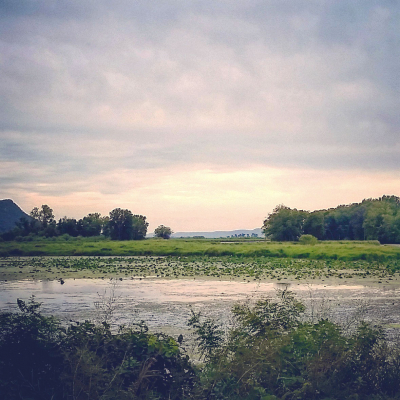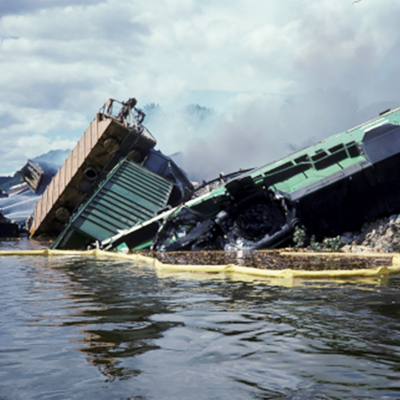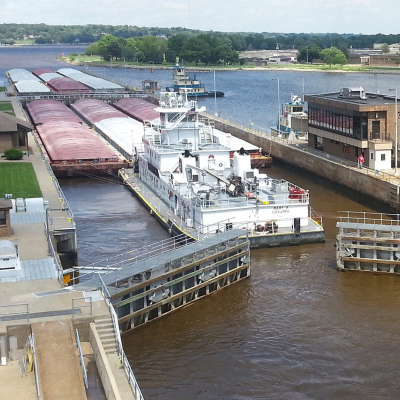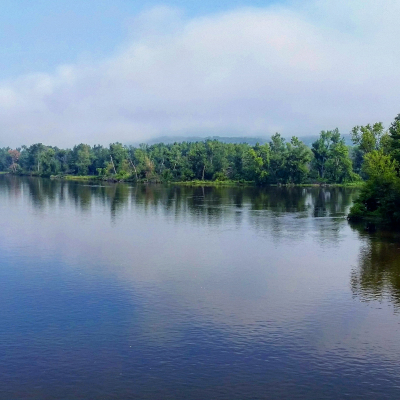The availability of clean water on the Upper Mississippi River and its watershed is essential for the health and wellbeing of people, fish, and wildlife
Protecting and improving water quality is essential for people and communities in the Upper Mississippi River basin. They rely on clean water for drinking, as well as for their businesses, industries, and farms. Clean water is also essential to the river ecosystem which in turn supports tourism, hunting, fishing, and other recreation. A healthy, clean Mississippi River is central to the success of river communities, our states, and the upper Midwest.
Managing for water quality on the Upper Mississippi River faces unique challenges as a shared border water under the jurisdiction of many states and federal authorities and as a physically complex ecosystem of pools, side channels, and backwaters that is also managed for commercial navigation. The sheer size and complexity of the river's large floodplain ecosystem make it particularly difficult to assess its water quality conditions. Variations in main channel, side channel, and backwater conditions are abundant. Due to dilution in a river of this size, many localized water quality phenomena cannot be detected without intensive monitoring and, in many instances, contaminants are present in concentrations below current analytical detection limits. The ability to extrapolate site-specific data to larger river reaches is limited. In addition, developing contaminant-specific, biological and nutrient criteria for large rivers is challenging due to the size and complexity of the aquatic environment.
The Upper Mississippi River's water quality has generally improved between 1989 and 2018, while there are pollutants of concern that have varying trends. Decreases in legacy heavy metals, sediment, and phosphorus, for example, show that public and private investments in managing water quality are beneficial and that the approaches taken have been effective. Nitrogen, chloride, and contemporary or emerging pollutants of concern, however, are rising and require a five-state approach to develop effective solutions.
While progress has been made in improving the river’s water quality since the passage of the Clean Water Act in 1972, challenges still exist in addressing issues such as reducing nutrient and sediment inputs, dealing with emerging contaminants, and preserving and protecting water quality gains made to date. Decaying infrastructure threatens the security of water supplies, sediment is filling in wetland habitats, nutrients are impairing water quality, and invasive species are harming native fish and wildlife. While the vast majority of fuel and hazardous materials shipments reach their destination without incident, a major spill could impact both water quality and ecosystem health.
Key Documents and Links
UMRBA Water Quality Program Plan
2022-2035 Water Quality Program Plan
Topic-Specific Internal Links
Interstate WQ (CWA) Monitoring Program
Nutrients (coming soon!)
Harmful Algal Blooms (coming soon!)
UMRBA Statements
Priority Solutions
UMRBA is the leading interstate, regional collaborative to assist the states in implementing the Clean Water Act and nutrient reduction strategies. UMRBA has long envisioned, and worked towards building, a layered and interwoven approach to water quality protection involving local, state, regional, and federal responsibilities, taking UMRBA beyond its currently successful, albeit modest, efforts to a more robust cooperative forum. The public both expects and deserves such a coordinated and comprehensive water quality strategy in alignment with watershed goals.
Ensuring available clean water resources requires restoring the ecosystem, addressing aging infrastructure, reducing nutrient loading, controlling invasive species, and planning for potential spills. It also requires monitoring and science to help us understand the system, measure progress, and choose the most effective future actions.
Protect and improve water quality
Augment capacity for the states' implementation of their nutrient reduction strategies. Determine water quality protection needs for the river, by developing a common set of designated uses, assessment protocols and listing criteria of priority water quality parameters. Engage in individual state stakeholder outreach. Develop recommendations for listings of priority water quality parameters. Research and incorporate new understandings of how future precipitation and discharge projections might affect the effectiveness of best management practices and detect emerging contaminants and evaluate the development of an emerging contaminant in the states’ CWA standards, criteria, and listings as desired and appropriate.
Monitor status and trends
Quantify, evaluate, and assess the sources, transport, and trends of sediment, nutrients, and other water quality parameter. Implement UMRBA’s Interstate Water Quality Monitoring Strategy to assess the status and trends of water quality parameters in the Upper Mississippi River mainstem. Monitor the effectiveness of nonpoint source runoff reduction best management practices – i.e., progress tracking. Integrate insights from relevant data sources – e.g., UMRR, Illinois LTEF, USGS IWS, Atlas-14, Illinois Bulletin 75. Research priority questions and enhance consistency and pursue proper data collection, analysis, storage, and dissemination.
Facilitate hazard mitigation planning
Enhance efforts to protect the public from cyanotoxins in drinking water and their adverse health effects and other hazardous spills. Provide helpful tools and information to better identify, monitoring, and manage harmful algal blooms, such as the UMR HAB Resource Response Manual, and develop and prioritize research objectives. Build and support collaborative approaches to adaptively manage HABs. Increase awareness and understanding of new research findings and innovative management tools.
UMRBA History
Assessing the River's Water Quality Conditions (1980s)
In 1989, UMRBA published the report, How Clean is the River?, to describe the water quality condition on the Upper Mississippi River. The report acknowledged that the states’ water quality standards affect the way they determine and describe water quality – i.e., “a state with less restrictive standards will likely consider the water quality of the river to be better than that described by a state with more restrictive standards.” Acknowledging the complexity and dynamic nature of the river system, the report concludes that no single monitoring approach was sufficient and examined water quality conditions through five different methods.
The report found that 69 percent of the river (approximately 583 miles) had water quality problems, with the majority of those problems concentrated at the upstream and downstream ends of the river. Stretches of the river with the best water quality were between L&Ds 10 and 19 as well as L&Ds 20 and 21 – i.e., away from the major metropolitan areas and major tributaries (Minnesota, Illinois, and Missouri Rivers). The most pervasive water quality problem was the degradation of the fishery resource. This report set the course in subsequent years for UMRBA’s focus on sedimentation and toxic pollutants.
Establishing UMRBA’s Water Quality Program (1990s)
UMRBA established a Water Quality Initiative in 1992 in order to design a regional, integrated water quality protection strategy with goals and objectives for future action. The Initiative focused on two primary issues: sedimentation and toxic pollution. Following several strategic planning sessions, UMRBA concluded that an effective water pollution control strategy would require significant, dedicated resources. Recognizing that federal support is not likely absent a strong expression of state support, the states would need to make a clear and definitive commitment to this effort at the highest policy level. UMRBA formed the WQTF in 1993 to create a long term water quality protection strategy for the river as well as to address more immediate issues. However, the WQTF was not sustained for a variety of reasons.
The 1993 Flood consumed much of the region's attention and required that UMRBA focus its water quality work by responding to questions about how to optimize future water quality monitoring during flood events. Specifically, how can water quality monitoring needs be identified in advance of a major flood? How can state and federal agencies work more effectively together to optimize limited resources toward meeting these needs? In 1995, UMRBA sponsored the 1993 Flood-Related Water Quality Monitoring Workshop. Among several recommendations, workshop participants concluded that interagency coordination of sampling locations, parameters, finances, and personnel would highly beneficial.
In 1997, the Upper Mississippi River Governors published a joint proclamation reaffirming their individual and collective support for UMRBA as the forum to unify the states’ river-related policies and to articulate their mutual concerns and shared vision for the river's management. This joint proclamation was used to established a partnering agreement between UMRBA and USEPA, whereby the states requested that USEPA recognize UMRBA as the states' interstate coordinating body for river-related issues.
UMRBA “revived” and basically created anew the WQTF in 1998 with its first meeting held on April 8, 1999. The UMRBA Board sought enhanced interstate coordination on water quality issues, specifically nutrients and Gulf of Mexico hypoxia, source water protection, unified watershed assessments, 303(d) listings and TMDLs, and biocriteria. At the time, USEPA was in the process of writing letters to the directors of each of the state environmental quality agencies, requesting that they support the formation of a group to specifically address biocriteria for the Upper Mississippi River.
Building An Interstate Program (2000 – Now)
The WQTF was primarily supported by federal and private grants in the 2000s, funding a dedicated, part-time UMRBA staff person to carryout project-specific objectives. In the early 2000s, UMRBA started to build the foundation of interstate water quality coordination by identifying and explaining the differences among the states’ policies and programs – e.g., designated uses and 305(b)/303(d) assessments. Section 104(b)(3) grant funding supported this work. Given that the Hypoxia Task Force focused on nutrient-related issues, UMRBA focused its attention on impaired waters.
In 2003, UMRBA's member states formally adopted an interstate MOU agreeing to utilize a common set of assessment reaches for use in the development of their CWA 305(b) assessments and 303(d) impaired waters listings. The use of uniform assessment reaches was viewed as a major accomplishment to facilitate interstate comparisons and to provide a common foundation for ongoing and future interstate coordination efforts.
UMRBA then published a 2004 report assessing the states' CWA implementation approaches, which acknowledged that inconsistencies among the five states’ 305(b) assessments and 303(d) impairment lists for the Upper Mississippi River may lead to unequal levels of protection. Inherent and significant challenges in applying the CWA framework on the Upper Mississippi River (and interstate waters more broadly) are due to scientific complexity, differences in state standards and impairment listings, political and policy limitations, lack of resources and priority, and the absence of a mechanism for interstate coordination.
Building from the 2004 report, UMRBA developed recommendations for enhancing consistency in the states’ fish consumption advisories (FCAs) and concluded that there should be consistent fish consumption advisories on the Upper Mississippi River among border states and that the states evaluate common contaminants and fish species and use the same methodologies.
In 2007, UMRBA published an issue paper on sediment-related water quality. Recognizing the potential problems associated with the current characterization of sediment impairments on the Upper Mississippi River, UMRBA concluded that the existing sediment regime is not in equilibrium and net deposition is occurring in certain areas of the river and its backwaters. Recommendations included that states and USEPA, working through UMRBA, express their shared commitment to working on these issues through an MOU and develop a guidance document for sediment-related water quality criteria, evaluate alternative approaches to address bedded sediment, and compile research needs to help guide further investigations.
In 2007-2008, UMRBA's WQEC and WQTF wrestled with the question of whether there should be a unique set of designated uses for the Upper Mississippi River. In 2009, UMRBA hosted a Clean Water Act-Ecosystem Restoration Workshop to explore the potential applications of biological indicators in CWA and ecosystem restoration programs on the river. One of most notable outgrowths from the workshop was the WQTF's development of biological assessment guidance. Around the same time, UMRBA applied for 604(b) funding to explore regional nutrient conversations by focusing on the water quality issues most pertinent to the mainstem Upper Mississippi River and by bringing together policy makers and practitioners from CWA and agricultural conservation programs.
UMRBA contracted with the Midwest Biodiversity Initiative (MBI) in 2010-2011 to develop recommendations for a potential biology-driven CWA aquatic life use assessment on the Upper Mississippi River. MBI recommended that a single entity manage and execute a future bioassessment because of standardization challenges under a multi-agency approach, but also for efficient study design, data management, and data analysis. A single entity should also organize a monitoring strategy for all aspects of a standardized main channel bioassessment, whether a single entity or multiple entities actually conduct the work. MBI suggested a series of next steps for the Upper Mississippi River state, with its recommended steps consuming the next few years of UMRBA's water quality work: develop a UMR‐wide CWA monitoring strategy incorporating biological indicators and develop an intensive, longitudinal pollution survey design as the core of a bioassessment strategy.
From 2009-2011 and in partnership with USEPA, UMRBA first focused its efforts aligning the states' CWA assessments on aquatic life designated uses because 1) the states all designate an aquatic life use for the Upper Mississippi River, 2) aquatic life use assessments are typically the most broadly‐based CWA assessments and therefore often act as drivers of assessment in general, and 3) this appears to be where the greatest need exists to better reflect the river's diverse characteristics in the states’ regulatory approaches. UMRBA evaluated existing data, which indicated significant physical, chemical, and biological diversity on the Upper Mississippi River in both spatial and temporal contexts. In the 2012 Aquatic Life Designated Uses report, UMRBA defined its next steps to incorporate the report's classification structure into the states' CWA water quality standards, to create an Upper Mississippi River CWA monitoring strategy, to identify water quality criteria, and to develop an assessment methodology, which would then be used to support a comprehensive and consistent aquatic life assessment.
In 2011, UMRBA published the Upper Mississippi River Nutrient Monitoring Occurrence and Local Impacts report that resulted in a suite of recommendations relate to monitoring and data collection; nutrient sources, concentrations, and trends; CWA designated uses; and CWA implementation.
The culmination of UMRBA’s work over time ultimately resulted in the development and implementation of the UMR Interstate Water Quality Recommended Monitoring Plan. [Note: The plan was originally called the CWA Recommend Monitoring Plan.] Through a 2014 UMRBA resolution, the states formally adopted the Plan and committed to securing the resources, developing the infrastructure, and establishing the procedures needed for implementation.
The Recommended Monitoring Plan provides a shared water quality monitoring approach based on the four designated uses of the river – i.e., recreation, aquatic life, fish consumption, and drinking water. The WQTF adopted the EMAP-GRE method in the Plan, and utilized USEPA ORD for consultation during the Plan’s development. While the states agreed that the shared monitoring would be implemented from 2013 to 2022, one piloting effort is complete and a second is in progress. The purpose for these pilots is to test and demonstrate the feasibility and effectiveness of the Recommended Monitoring Plan. Minnesota and Wisconsin implemented the first pilot in Clean Water Act Reaches 0-3 in 2016 after about two years of intensive planning. Illinois, Iowa, and Missouri are participating in the second pilot on Reaches 8-9. Relevant documents developed to aid the Reaches 0-3 pilot’s implementation included the Provisional Assessment (2017) and the Field Operations Manual (2017). Many lessons learned were carried into the Reaches 8-9 pilot. After the conclusion of the Reaches 8-9 pilot, the water quality committees will discuss how the Recommended Monitoring Plan can be implemented and scaled up to the entire UMR and whether there is a dedicated and consistent funding source. Another major consideration is whether the EMAP-GRE method is still suitable for the Recommended Monitoring Plan, given that LTRM crews have been involved in implementing the pilot projects.




